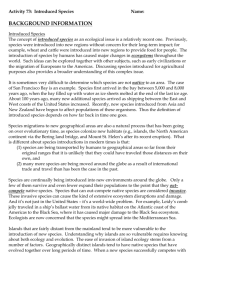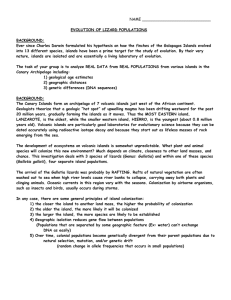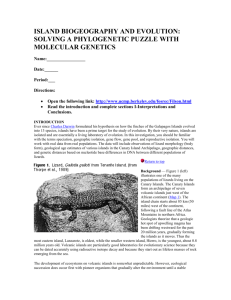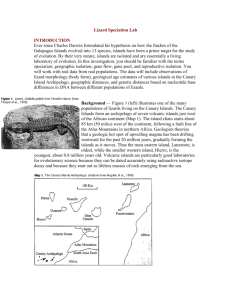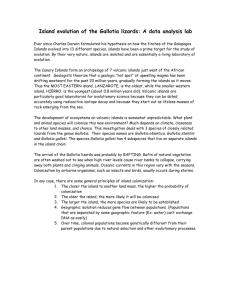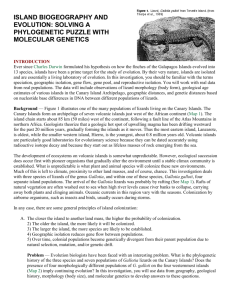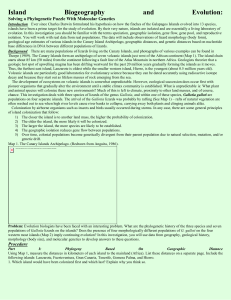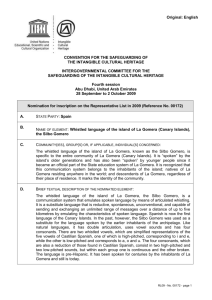part i: phylogeny based on geographic distance
advertisement
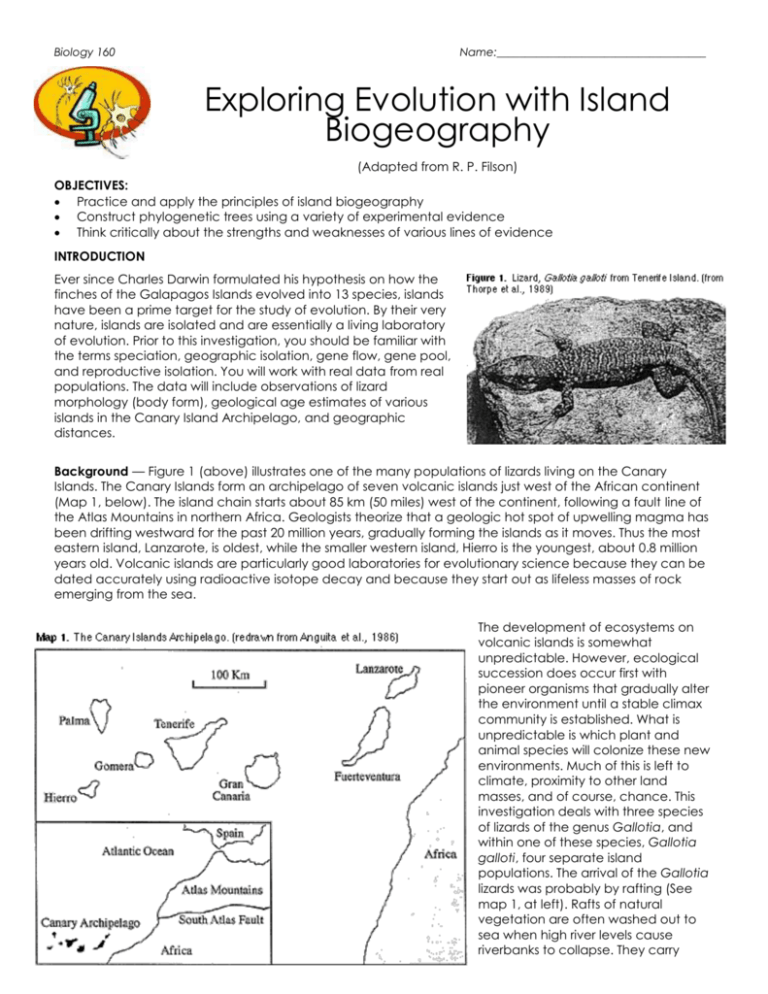
Biology 160 Name:_____________________________________ Exploring Evolution with Island Biogeography (Adapted from R. P. Filson) OBJECTIVES: Practice and apply the principles of island biogeography Construct phylogenetic trees using a variety of experimental evidence Think critically about the strengths and weaknesses of various lines of evidence INTRODUCTION Ever since Charles Darwin formulated his hypothesis on how the finches of the Galapagos Islands evolved into 13 species, islands have been a prime target for the study of evolution. By their very nature, islands are isolated and are essentially a living laboratory of evolution. Prior to this investigation, you should be familiar with the terms speciation, geographic isolation, gene flow, gene pool, and reproductive isolation. You will work with real data from real populations. The data will include observations of lizard morphology (body form), geological age estimates of various islands in the Canary Island Archipelago, and geographic distances. Background — Figure 1 (above) illustrates one of the many populations of lizards living on the Canary Islands. The Canary Islands form an archipelago of seven volcanic islands just west of the African continent (Map 1, below). The island chain starts about 85 km (50 miles) west of the continent, following a fault line of the Atlas Mountains in northern Africa. Geologists theorize that a geologic hot spot of upwelling magma has been drifting westward for the past 20 million years, gradually forming the islands as it moves. Thus the most eastern island, Lanzarote, is oldest, while the smaller western island, Hierro is the youngest, about 0.8 million years old. Volcanic islands are particularly good laboratories for evolutionary science because they can be dated accurately using radioactive isotope decay and because they start out as lifeless masses of rock emerging from the sea. The development of ecosystems on volcanic islands is somewhat unpredictable. However, ecological succession does occur first with pioneer organisms that gradually alter the environment until a stable climax community is established. What is unpredictable is which plant and animal species will colonize these new environments. Much of this is left to climate, proximity to other land masses, and of course, chance. This investigation deals with three species of lizards of the genus Gallotia, and within one of these species, Gallotia galloti, four separate island populations. The arrival of the Gallotia lizards was probably by rafting (See map 1, at left). Rafts of natural vegetation are often washed out to sea when high river levels cause riverbanks to collapse. They carry away both plants and clinging animals alike. Colonization by airborne organisms, such as insects and birds, usually occurs during storms. In any case, there are some general principles of island colonization: 1) The closer the island to another land mass, the higher the probability of colonization. 2) The older the island, the more likely it will be colonized. 3) The larger the island, the more species are likely to be established. 4) Geographic isolation reduces gene flow between populations. 5) Over time, colonial populations become genetically divergent from their parent population due to natural selection, mutation, and/or genetic drift. Problem — Evolution biologists have been faced with an interesting problem. What is the phylogenetic history of the three species and seven populations of Gallotia lizards on the Canary Islands? Does the presence of four morphologically different populations of G. galloti on the four western most islands (Map 2) imply continuing evolution? In this investigation, you will use data from geography, geological history, morphology (body size), and molecular genetics to develop answers to these questions. PART I: PHYLOGENY BASED ON GEOGRAPHIC DISTANCE Procedure — Using Map 1, measure the approximate distance in kilometers of each island to the mainland (Africa). List these distances below. Include the following islands: 1) Approximate distances from the mainland: Lanzarote: _______ Fuerteventura: _______ Gran Canaria: _______ Gomera: _______ Palma: _______ Hierro: _______ Tenerife: _______ 2) With your group, decide which island is most likely to have been colonized first and which last. Why do you think so? 2) Using Map 2 (next page) and your geographic reasoning, draw a hypothetical phylogenetic (family) tree of the three species and the three additional populations of G. galloti in the space below. Label your end branches with the following population names: atlantica, stehlini, galloti Tenerife, galloti Palma, galloti Gomera, galloti Hierro. PART II: PHYLOGENY BASED ON GEOLOGICAL HISTORY Check your hypothetical phylogenetic tree against the geological data in the Table 1. The maximum age of each island was estimated by sampling volcanic rocks found on all islands. The ratio of radioactive potassium to its breakdown product argon was used to estimate the age of the rocks. Table 1. Maximum age of the Canary Islands in millions of years. (Anguita et.al., 1986) Lanzarote & Fuerteventura Gran Canaria Tenerife Gomera Palma Hierro 24.0 17.1 15.1 5.3 2.0 0.8 1) Do the data in Table 1 support the hypothesis you presented in the phylogenetic tree you drew in Part 1. If not, what changes should you make and why? PART III: PHYLOGENY BASED ON MORPHOLOGY Study the drawings from each lizard population in Figure 2 at right. Compare and contrast their body size with the distribution on Map 2. To be sure differences were genetic, not ecological, researchers collected individuals from all island populations and bred and raised them in the captivity. Their offspring still displayed differences according to their parental characteristics. 1) In the space below, draw a new phylogeny chart based on morphological similarities and differences. 2) With your group, compare your two phylogeny charts. What differences do you notice? 3) If this was your research, what would you do next? Explain. PART IV: Thinking About Natural Selection in the Gallotia Lizards Researchers studying these lizards noticed that Tenerife island was quite different on the North and South ends. In particular, the north end is moist and lush while the south is arid and barren. 1. Could this difference in climate create unique selection pressures on the north and south ends of Tenerife? If so, how? Explain. 2. If the selection pressures were different on the two ends of the islands, what do you think might happen, over time, to the lizard populations on each end? 3. If you subsequently observed lizards migrating regularly between the north and south populations, how would you change the predictions you describe in question 2 (above)? Notice that the four outer islands, Tenerife, Gomera, Palma, and Hierro, are inhabited by four unique populations of lizards belonging to the same species! In addition to the morphological differences described above, researchers have also observed some differences in their DNA sequences. 4. Considering these differences, what do you predict what is likely to happen to the four populations of G. galloti on these four western-most islands? What conditions support your predictions? REFERENCES Anguita, F., and F. Hernan, 1986, Geochronology of some Canarian dike swarms: contribution to the volcano-tectonic evolution of the archipelago, Journal of Volcanology and Geothermal Research, 30: 155-162. Thorpe, R.S. and R.P. Brown, 1989, Microgeographic variation of the colour pattern of Canary Island lizard, Gallotia galloti within the island of Tenerife: distribution, pattern and hypothesis, Biological Journal of the Linnean Society, 38: 303-322. Thorpe, R.S., D.P. McGregor, and A.M. Cumming, 1993. Population Evolution of Canary Island lizards, Gallotia galloti: four base endonuclease restriction of fragment length polymorphisms of mitochondrial DNA, Biological Journal of the Linnean Society, 49: 219- 227. Thorpe, R.S., R.P. Brown, M. Day, A. Malhotra, D.P. McGregor, and W. Wuster, Testing ecological and phylogenetic hypotheses in microevolutionary studies, pages 189-206 in E.P. Eggleton and R. Vane-Wright, editors. Phylogenetics and ecology, 1994, Academic Press, London. Thorpe, R.S., D.P. McGregor, A.M. Cumming, and W.C. Jordan, 1994, DNA Evolution and Colonization Sequence of Island Lizards in Relation to Geological History, Evolution, 48: 230-240.


